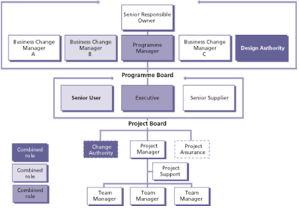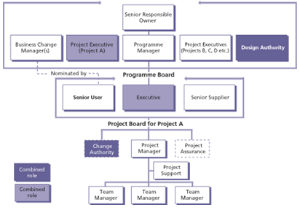PRINCE2 2009 - Tailoring PRINCE2 part 12
of the Cabinet Office under delegated authority from the Controller of HMSO.
Tailoring PRINCE2® to the project environment
Projects in a programme environment
Themes
OrganizationOGC’s Managing Successful Programmes (MSP®) framework defines a programme board that comprises a programme Senior Responsible Owner (SRO), a programme manager, one or more business change managers, representatives of corporate functions as necessary (e.g. human resources, finance), the lead supplier, and the project Executives of the projects within the programme.
The programme SRO is the single individual with overall responsibility for ensuring that a programme will meet its objectives and deliver the projected benefits.
It is likely that the programme SRO will confirm the appointment of the project Executive.
The programme manager is responsible for the set-up and day-to-day management and delivery of the programme on behalf of the programme SRO.
The business change manager is responsible for benefits definition and management throughout the programme.
This role provides the bridge between the programme and business operations to ensure that the capabilities delivered by the projects are adopted by the organization in order to achieve the desired outcome and their subsequent benefits.
The programme and project management team structures need to be integrated such that:
- There are clear lines of responsibility from top to bottom (i.e. everyone is accountable to someone)
- Duplication is avoided
- Reports and reviews are efficient (e.g. four projects within a programme have common Project Board members and by aligning stage boundaries they meet collectively to conduct end stage assessments for all four projects as part of a programme review).
The integration of roles may include:
- The programme manager being the Executive for one or more of the projects
- A business change manager from the programme fulfilling the project role of Senior User (or having input in the appointment of the Senior User) for one or more of the projects, or being the project Executive for one or more of the projects
- Project Support being provided by the programme
- The programme’s design authority (if used) fulfilling the project role of Change Authority or Project Assurance for one or more of the projects as the purpose of a design authority at a programme level is to ensure that there is appropriate alignment and control when changes are being planned and implemented.
The choice of structure and appointments will depend on the scale and complexity of the programme.
The pros and cons of the choice of organization structure and appointments need to be evaluated along with their consequences.
Diagram 2
For example, in diagram 2, where the programme manager is also the Executive of one of the projects within the programme, consideration should be given as to how exceptions will be escalated between the project and the programme, and whether any additional assurance mechanisms need to be established.
Diagram 1
See diagram 1 (Organization structure with the Executive being a member of the programme board and the Senior User being nominated by the relevant business change manager) and diagram 2 (Organization structure with the programme manager as the project Executive and the Senior User role on the project being undertaken by the relevant business change manager) for two examples.
The project’s Communication Management Strategy will be derived from the programme’s stakeholder engagement strategy, with communications being controlled and scheduled as part of the programme communications plan.
Stakeholder analysis for the project may be performed by the programme, or the programme may require the project to take a lead with certain stakeholder groups with which it has good engagement.
PRINCE2® is a Registered Trade Mark of the Office of Government Commerce in the United Kingdom and other countries.
MSP® is a Registered Trade Mark of the Office of Government Commerce in the United Kingdom and other countries.
Managing Successful Projects with PRINCE2 - 2005 edition
Managing successful Projects with PRINCE2 – 2009 edition
Directing Projects with PRINCE2.
plus:
The Complete Project Management package.
And much more besides - at a fantastic price.





